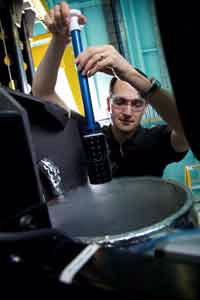

Published on the 28th February 2017 by ANSTO Staff
Collaboration across the Tasman has enabled Australian and New Zealand researchers and scientists to shed light on a protein involved in diseases such as Parkinson’s disease, gastric cancer and melanoma.
The Australian Synchrotron in Melbourne was used by researchers from the University of Otago, in collaboration with Australian scientists, with the results published today in leading international journal PNAS.
The team of researchers, led by Otago Department of Biochemistry’s Dr Peter Mace, studied a protein called Apoptosis signal-regulating kinase 1 (ASK1).
Dr Mace says the protein plays an important role in controlling how a cell responds to cell damage, and can push the cell towards a process of programmed cell death for the good of the body, if damage to a cell is too great.
“We now know a lot more about how ASK1 gets turned on and off – this is important because in diseases such as Parkinson’s, stomach cancer and melanoma, there can be either too much or too little ASK1 activity,” he said.
The ASK1 protein gets its name from an ancient Greek word meaning “falling off” – apoptosis – and is used to describe the process of programmed dying of cells – of the body actively killing them – rather than their loss by injury.
They found that ASK1 has unexpected parts to its structure, that help control how the protein is turned on, and that an entire family of ASK kinases share these features.
Dr Mace says that the new findings add to our understanding of how cells can trigger specific responses to different threats or damage encountered, such as oxidants, which damage the body’s tissues by causing inflammation.
He adds that kinases are excellent targets for developing new drugs because they have a “pocket” in their structure that such compounds can bind to, but to develop better drugs we need to understand far more about how they are controlled. This is the goal of several projects in his lab, he says.
The research team determined ASK1’s molecular structure through crystallography studies – using the Synchrotron to see exactly what it is made up of – and performed other biochemical experiments to better understand the protein.
Dr Tom Caradoc-Davies, (below right) a Principal Scientist at the Australian Synchrotron, helped to collect data critical to the project.
 |
“Using the Synchrotron’s MX Beamlines, we collected data from difficult samples, to help solve questions the research team had about the structure of the protein,” Dr Caradoc-Davies said.
“This is a great example of how regular access to the Synchrotron’s facilities can help move a project along more rapidly than otherwise would be the case, where it could take many years more for a team to find an answer, or they may not be able to find one at all.”
The study is a collaboration between Otago researchers and scientists at the Walter and Eliza Hall Institute (WEHI) in Melbourne, and at the Australian Synchrotron.
Access to ANSTO’s Synchrotron facility was enabled by the New Zealand Synchrotron Group, which is coordinated by the Royal Society of New Zealand and supported by all New Zealand universities in partnership with the Australian and New Zealand Governments.
The Australian Synchrotron is crucial to many other research projects from Otago and throughout New Zealand.
The study was supported by a Royal Society of New Zealand Rutherford Discovery Fellowship and grants from the University of Otago, the Victorian State Government and the National Health and Medical Research Council.